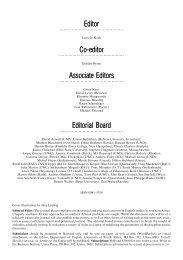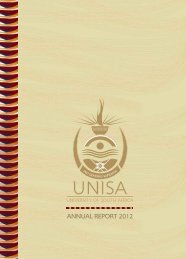pdf: 6.426kb - University of South Africa
pdf: 6.426kb - University of South Africa
pdf: 6.426kb - University of South Africa
You also want an ePaper? Increase the reach of your titles
YUMPU automatically turns print PDFs into web optimized ePapers that Google loves.
The following is an effort to provide some cultural<br />
background which may be helpful in understanding<br />
the business environment <strong>of</strong> Brazil and, consequently,<br />
in minimizing risks. It is my firm belief that MBA<br />
programmes today not only fail disgracefully in this<br />
regard, but rather make matters much worse in<br />
promoting the `cowboy' business ethics, according<br />
to which pr<strong>of</strong>it at all costs is the basic cannon as well<br />
as the ultimate truth and exclusive end <strong>of</strong> society.<br />
Brazil was discovered by the Portuguese 500 years<br />
ago, on 22 April 1500, when a fleet <strong>of</strong> thirteen ships<br />
commanded by navigator Pedro AÂ lvares Cabral arrived<br />
in the shores <strong>of</strong> what is now the state <strong>of</strong> Bahia. His<br />
expedition represented the <strong>of</strong>ficial claim by Portugal<br />
<strong>of</strong> the lands apportioned to it by the Treaty <strong>of</strong><br />
Tordesillas <strong>of</strong> 7 June 1494, mediated by Pope<br />
Alexander VI, that allocated rights <strong>of</strong> the discoveries<br />
between Spain and Portugal. Spain was to receive the<br />
territories west <strong>of</strong> the Tordesillas line, as long as<br />
Portugal would acquire the lands to its east. In 1500,<br />
the population <strong>of</strong> Portugal was only approximately<br />
1 100 000 people or 280 000 households. The<br />
country's human resources were already over-extended<br />
by the impact <strong>of</strong> the discovery by Admiral<br />
Vasco da Gama <strong>of</strong> the naval route to India in 1498 and<br />
the need to man trading stations in <strong>Africa</strong>, in India, in<br />
Malaga and subsequently in China and Japan. It has<br />
been estimated that in the first half <strong>of</strong> the sixteenth<br />
century, 80 per cent <strong>of</strong> Portugal's male population<br />
was in colonial or trade service abroad.<br />
Portugal had become a nation state and a separate<br />
kingdom since 1139, with the Frenchman Henry <strong>of</strong><br />
Bourgogne as its first king, had already expelled the<br />
moors from its territories in 1239, and successfully<br />
fought <strong>of</strong>f Spain's attempts <strong>of</strong> domination. Conversely,<br />
Spain only began to be a nation state at the end<br />
<strong>of</strong> the fifteenth century and expelled the Moors only<br />
in 1492, the year Columbus discovered America. This<br />
situation determined the attitude <strong>of</strong> the two countries<br />
towards their new colonies: whereas the Spaniards<br />
continued the ruthless military campaign against the<br />
infidels, supported by a very militant Catholic Church,<br />
the Portuguese adopted an <strong>of</strong>ficial policy <strong>of</strong> racial<br />
miscegenation.<br />
When the Portuguese arrived, in 1500, Brazil was<br />
inhabited by approximately five million native Brazilians,<br />
<strong>of</strong> numerous different indigenous peoples, who<br />
spoke languages now classified into four main groups.<br />
Upon disembarkation, the Portuguese were promptly<br />
met by waiting friendly Tupinikins. The predominant<br />
language group, also spoken by the Tupinikins, used<br />
in most <strong>of</strong> the coast areas and deep into the interior up<br />
to the Amazon and what is now Paraguay, Uruguay<br />
and parts <strong>of</strong> Argentina was the Tupi-Guarani, known<br />
in some areas in this language as `nhenhen-gatu', or<br />
general language. The indigenous tribes called their<br />
land pindorama or land <strong>of</strong> the palm trees. They were<br />
basically hunter-gatherers, but also cultivated some<br />
basic crops, such as manioc, peanuts and cotton. They<br />
had a pr<strong>of</strong>ound knowledge <strong>of</strong> and respect for the land,<br />
knew cartography, navigation by the sun and by the<br />
stars and had numerous musical instruments. The<br />
basic artistic manifestations were plumery art and<br />
body painting. Their botanical knowledge was pr<strong>of</strong>ound.<br />
The native Brazilians were in constant warfare. It<br />
was speculated by contemporary European travellers<br />
that this was necessary as a means <strong>of</strong> population<br />
control. When the Portuguese arrived in Pindorama,<br />
the Tupi-Guarani Indians were asserting control <strong>of</strong> the<br />
coastal regions <strong>of</strong> the country. They had their own<br />
legal system, evidenced by extant terms in the Tupi-<br />
Guarani vocabulary for lawyer, court, court-house,<br />
defence, sentence and other terms indispensable for<br />
the functioning <strong>of</strong> a legal society. Violence within the<br />
tribes was practically non-existent. When it occurred,<br />
the aggrieved, or their families, would be authorized to<br />
redress the damage in the same manner as it was<br />
inflicted. Property was communal. The tribes were<br />
nomads, so as not to exhaust the land, and thus there<br />
was no accumulation <strong>of</strong> riches. The ultimate sanction<br />
was a social penalty: exclusion from the tribe.<br />
Prisoners <strong>of</strong> war would be normally integrated into<br />
the tribes as labourers, but not warriors. In many<br />
tribes, the bravest prisoners would be subject to ritual<br />
cannibalism.<br />
The Portuguese settled along the coastline <strong>of</strong> the<br />
country, which they initially called the Land <strong>of</strong> True<br />
Cross. After approximately 20 years, the country<br />
began to be called Brazil, after its main produce, the<br />
Brazil wood, used as a red dye. The origin <strong>of</strong> the name<br />
comes from the Italian Verzino through the French<br />
Bre sil. Early on the Portuguese tried to impose their<br />
culture, including religion and laws, on the native<br />
population, as well as attempting to enslave it to be<br />
put to economic use. The natives almost immediately<br />
started a movement <strong>of</strong> civil resistance against the new<br />
order, by moving further inland. They resisted slavery<br />
to such extent that they did not hesitate to commit<br />
suicide in great numbers immediately after capture.<br />
There are many extraordinary written accounts <strong>of</strong> how<br />
native Brazilians would die in such circumstances,<br />
including various after pronouncing the formula `I die'<br />
three times. By this movement <strong>of</strong> civil resistance, the<br />
Brazilian indigenous people not only refused the<br />
unjust law or practice <strong>of</strong> slavery, but also declined to<br />
accept the artificial frontiers imposed by alien powers.<br />
On both accounts they ultimately prevailed. 1<br />
Simultaneously, the Portuguese proceeded with<br />
understandable delight with their policy <strong>of</strong> miscegenation.<br />
There are accounts <strong>of</strong> some who had as<br />
many as 60 wives, which gave them enormous<br />
political power. This is so because Brazilian indigenous<br />
peoples also had a policy <strong>of</strong> social co-optation. 2<br />
ISSN 0256±6060±Unisa Lat. Am. Rep. 16(2) 2000 37

















